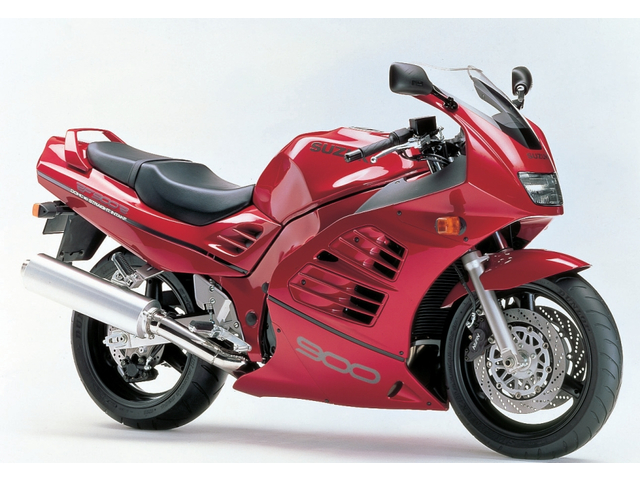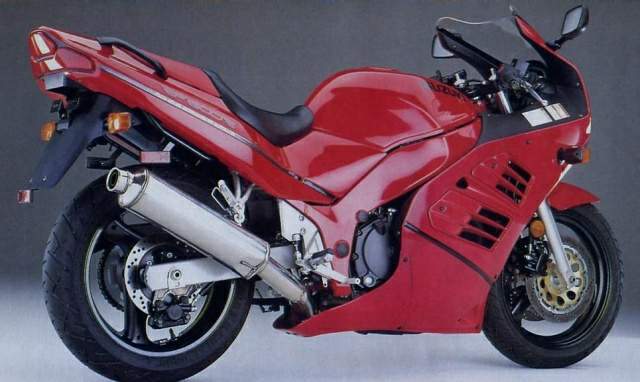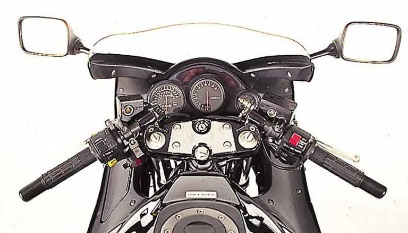Motorcycle Investor mag
Subscribe to our free email news
Motorcycle profile – Suzuki RF900R

(by Guy 'Guido' Allen, July 2020)

The Middleman
Suzuki’s RF900R seemed like an anomaly when it was launched, but these days is a much under-rated model
The mid-1990s was a challenging time to be dropping a new motorcycle into the market. While sales were slow, having effectively fallen off a cliff from the later eighties in most western markets, the technology race had far from diminished. Quite the opposite.
This was an environment where the Ducati 916 was ruling world superbike (winning the title in 1994-95-96), Honda’s Fireblade was maturing as a truly formidable product, while Kawasaki’s 280km/h ZZ-R1100 was the top speed king. And then Suzuki wandered into view, with a steel-framed 900 kinda middle-of-the-road sports tourer. Interesting.
This was 1994 and the model lasted five years, during which time it scored respectable sales but was never a headliner. These days, I suspect 90 per cent of riders couldn’t identify the model, even if you ran over their foot with it. However, talk to anyone who’s had a proper ride on one of these things, and they’ll tell you that the RF nine deserved more.
There was also a very capable 600, below, plus a domestic model 400.

At a time when makers were very keen on alloy frames, high-end engines and clean-sheet designs, it was a little weird to see the spec sheet for this thing, which read a little bit like a parts bin special. Much of the powerplant (particularly the bottom end) was derived from the GSX-R1100W, albeit pulled back to a 937cc capacity. Liquid-cooled, it ran four valves per pot, relatively modest carburettors at 36mm, but a screaming 12,000rpm redline. However max power was developed much earlier at 10,000 and was a very solid 135 horses (98kW).
That lot was tied to a wet clutch, of course, and a five-speed transmission. The latter was also largely GSX-R derived, but the decision to go one cog short of what was by now the standard at six speeds was an intriguing one.
The real surprise was the frame. It was a steel perimeter unit, somewhat cheekily finished to look like aluminium twin beam. Maybe it was a cost-saving measure – in any case it more than did the job. Suspension was average spec for the time. Up front you scored 41mm forks with preload adjustment only. That was later (from 1996) updated with the addition of rebound damping adjustment. Out back you got a monoshock with full adjustment.
Braking was handled by four-piston Nissin calipers on the front, working 310mm discs, and a single 245mm disc on the rear with a two-spotter. Forget ABS or any of that other trickery.
When you scoped the overall set-up, there were some useful features for the rider wanting something that could handle a bit of distance work. For a start the fairing provided a fair degree of coverage and there was a generous pilot seat. Pillion accommodation was okay, though the footpegs were too high to win hearts as a pukka two-up tourer. It was more of a short hop for a coffee proposition for your loved one. On the plus side you had a decent range thanks to the 21 litre fuel tank, though there was no gauge.
Now here’s the truly odd part: Suzuki made mention in its publicity blurb that the RF900’s stylists were inspired by a manta ray they’d seen at an aquarium. A late variant was painted a handsome green and actually called the Manta. It could have been worse, I suppose – it could have been a puffer fish. Really, the reference was a little odd, particularly given the most striking feature of the motorcycle – those dramatic ‘gills’ or air vents cut into the fairing – if anything were reminiscent of a Ferrari Testarossa. I know which reference I would have gone for…
Now here’s a bit of styling trivia for you: the RF was adorned with what was then regarded as the largest-ever tail-lamp ever fitted to a motorcycle. We’re doubtful that it would still win that title, but it remains an impressive expanse of red plastic.
When the RF rolled out into the sun light in 1994, priced at $14,000 plus ORC, its direct competition was Kawasaki’s excellent ZX-9R at closer to $16,000 and Honda’s now ageing but much-loved VFR750 at $13,500. The latter may have been playing a little above its weight division, but had long been the exemplar of what a middleweight sports-tourer should be.

For whatever reason, the RF900 didn’t have the sheer glamour factor of the Kawasaki, but its price advantage certainly gave it a boost in the showroom. And here’s the other thing: the RF did very well in road tests, giving away surprisingly little to anything else within cooee of its engine capacity.
The 135 claimed horses gave it more top-end than you could use on the road (255km/h), while its real-world delivery of low and middle range power was excellent. This was a genuinely quick motorcycle and certainly gave away nothing meaningful on the road to allegedly quicker motorcycles.
Handling was generally very good. The suspension was well-sorted and the overall geometry was conservative – aimed at being reassuring rather than quick and razor-sharp. This, combined with effective brakes, made it a very quick road bike.
It was also a pretty good place to be if you were out for a ride with mates over a few days. It was reasonably comfortable, had decent fuel range, and was a fuss-free and trustworthy thing to ride.
Reliability over the long term is generally very good. Two issues are known: carburettor choke linkages can seize up over time and the alternator cush drive can give way. The first generally happens through lack of use while the latter is pretty rare.
The good news is that access for servicing is pretty good for a bike of this type, while the valve lash is adjustment is screw and locknut. That last feature potentially put it in relatively easy reach of the home mechanic.
They’re certainly not on the collector radar at the moment and will probably never be regarded as a major classic. However any relatively high-end model of this era will have collector interest in the future and, for the time being, prices are very low at around $3000-4000 for a clean example. Early ones are also in reach of club registration in Victoria and not that far away in other states.
So what you get is something that works well now and represents good value for money. A well-kept one should at least return your money. What’s not to like?
***
Good
Fast
Easy to live with
Ferrari gills!
Bad
Not well-known
Not a lot out there

SPECS:
Suzuki RF900R (1994-1999)
ENGINE:
TYPE: Liquid-cooled, four-valves-per-cylinder, inline four
CAPACITY: 937cc
BORE & STROKE: 73 x 56mm
COMPRESSION RATIO: 11.3:1
FUEL SYSTEM: 36mm Mikuni BDST carburettors
TRANSMISSION:
TYPE: Five-speed, constant-mesh,
FINAL DRIVE: Chain
CHASSIS & RUNNING GEAR:
FRAME TYPE: Steel twin-spar
FRONT SUSPENSION: Conventional telescopic fork, 41mm, preload adjustment only
(rebound damping adjustment 1996-0n)
REAR SUSPENSION: Monoshock, full adjustment
FRONT BRAKE: 310mm disc with four-piston Nissin calipers
REAR BRAKE: 245mm disc with two-piston caliper
DIMENSIONS & CAPACITIES:
WET WEIGHT: 225kg
SEAT HEIGHT: 805mm
WHEELBASE: 1422mm
FUEL CAPACITY: 21L
TYRES:
FRONT: 120/70-17
REAR: 170/60-17
PERFORMANCE:
POWER: 98kW @ 10,000rpm
TORQUE: 100Nm @ 9000rpm
OTHER STUFF:
PRICE WHEN NEW: $14,000 plus ORC
-------------------------------------------------
Produced by AllMoto abn 61 400 694 722
Privacy: we do not collect cookies or any other data.

Archives
Contact



